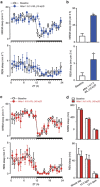Red light at intensities above 10 lx alters sleep-wake behavior in mice
- PMID: 30167247
- PMCID: PMC6062196
- DOI: 10.1038/lsa.2016.231
Red light at intensities above 10 lx alters sleep-wake behavior in mice
Abstract
Sleep is regulated by two mechanisms: the homeostatic process and the circadian clock. Light affects sleep and alertness by entraining the circadian clock, and acutely inducing sleep/alertness, in a manner mediated by intrinsically photosensitive retinal ganglion cells. Because intrinsically photosensitive retinal ganglion cells are believed to be minimally sensitive to red light, which is widely used for illumination to reduce the photic disturbance to nocturnal animals during the dark phase. However, the appropriate intensity of the red light is unknown. In the present study, we recorded electroencephalograms and electromyograms of freely moving mice to investigate the effects of red light emitted by light-emitting diodes at different intensities and for different durations on the sleep-wake behavior of mice. White light was used as a control. Unexpectedly, red light exerted potent sleep-inducing effects and changed the sleep architecture in terms of the duration and number of sleep episodes, the stage transition, and the EEG power density when the intensity was >20 lx. Subsequently, we lowered the light intensity and demonstrated that red light at or below 10 lx did not affect sleep-wake behavior. White light markedly induced sleep and disrupted sleep architecture even at an intensity as low as 10 lx. Our findings highlight the importance of limiting the intensity of red light (⩽10 lx) to avoid optical influence in nocturnal behavioral experiments, particularly in the field of sleep and circadian research.
Keywords: circadian; light; light-emitting diode; masking.
Conflict of interest statement
The authors declare no conflict of interest.
Figures






Similar articles
-
Phasic response of the photoperiodic clock to wavelength and intensity of light in the redheaded bunting, Emberiza bruniceps.Physiol Behav. 2000 May;69(3):277-83. doi: 10.1016/s0031-9384(99)00247-4. Physiol Behav. 2000. PMID: 10869593
-
Non-circadian direct effects of light on sleep and alertness: lessons from transgenic mouse models.Sleep Med Rev. 2013 Dec;17(6):445-52. doi: 10.1016/j.smrv.2012.12.004. Epub 2013 Apr 17. Sleep Med Rev. 2013. PMID: 23602126 Review.
-
Differential arousal regulation by prokineticin 2 signaling in the nocturnal mouse and the diurnal monkey.Mol Brain. 2016 Aug 18;9(1):78. doi: 10.1186/s13041-016-0255-x. Mol Brain. 2016. PMID: 27535380 Free PMC article.
-
Effects of wavelength and intensity of light in initiation of body fattening and gonadal growth in a migratory bunting under complete and skeleton photoperiods.Physiol Behav. 1996 Aug;60(2):625-31. doi: 10.1016/s0031-9384(96)80040-0. Physiol Behav. 1996. PMID: 8840927
-
Social influences on mammalian circadian rhythms: animal and human studies.Biol Rev Camb Philos Soc. 2004 Aug;79(3):533-56. doi: 10.1017/s1464793103006353. Biol Rev Camb Philos Soc. 2004. PMID: 15366762 Review.
Cited by
-
Influence of lighting on sleep behaviour, circadian rhythm and spontaneous blink rate in stabled riding school horses (Equus caballus).PLoS One. 2025 Jun 27;20(6):e0326567. doi: 10.1371/journal.pone.0326567. eCollection 2025. PLoS One. 2025. PMID: 40577374 Free PMC article.
-
Whole-brain monosynaptic inputs to lateral periaqueductal gray glutamatergic neurons in mice.CNS Neurosci Ther. 2023 Dec;29(12):4147-4159. doi: 10.1111/cns.14338. Epub 2023 Jul 9. CNS Neurosci Ther. 2023. PMID: 37424163 Free PMC article.
-
Effects of Illumination Color on Hypothalamic Appetite-Regulating Gene Expression and Glycolipid Metabolism.Nutrients. 2024 Dec 15;16(24):4330. doi: 10.3390/nu16244330. Nutrients. 2024. PMID: 39770951 Free PMC article.
-
Decreased circadian fluctuation in cognitive behaviors and synaptic plasticity in APP/PS1 transgenic mice.Metab Brain Dis. 2020 Feb;35(2):343-352. doi: 10.1007/s11011-019-00531-z. Epub 2019 Dec 26. Metab Brain Dis. 2020. PMID: 31879834
-
Several biological benefits of the low color temperature light-emitting diodes based normal indoor lighting source.Sci Rep. 2019 May 17;9(1):7560. doi: 10.1038/s41598-019-43864-6. Sci Rep. 2019. PMID: 31101840 Free PMC article.
References
-
- Borbély AA. A two process model of sleep regulation. Hum Neurobiol 1982; 1: 195–204. - PubMed
-
- Daan S, Beersma DG, Borbély AA. Timing of human sleep: recovery process gated by a circadian pacemaker. Am J Physiol 1984; 246: R161–R183. - PubMed
-
- Golombek DA, Rosenstein RE. Physiology of circadian entrainment. Physiol Rev 2010; 90: 1063–1102. - PubMed
LinkOut - more resources
Full Text Sources
Other Literature Sources

